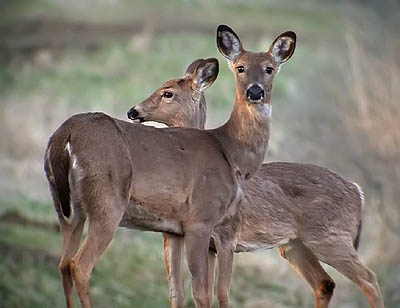The most wide-scale deer management problem facing whitetail herds in the many parts of the country is competition for available forage by white-tailed deer, other wildlife species, and livestock. Excessive numbers of any of these animals will have detrimental effects upon the others, and the resulting deer habitat. The first step in developing a deer management plan is to identify the “right” number of deer for the habitat found on your property.
The importance of maintaining deer at carrying capacity — the population level that prevents damage to the habitat — by the direct harvest of surplus deer can not be stressed enough. However, livestock and competing wildlife, such as exotic ungulates, also must be maintained within the bounds of the carrying capacity of the habitat. The key to good whitetail deer management is allowing deer to be as healthy as possible, which means that deer on your property are getting all the food they need. You can increase the amount of food per animal by either decreasing the deer herd or improving and enhancing the food supply through habitat management.

In either case, the deer population will likely have to be reduced first, and is usually the second item any deer management plan will address. However, this is not always the case and deer surveys will have to be conducted prior to pulling the trigger. Remember that all grazing and browsing animals on the property must be considered in order to determine proper deer capacity. Most landowners fail to recognize upfront that deer food is found in limited supply on the landscape.
Whitetail habitat should provide the basic necessities of life which include nutrition, water, and cover — the definition of habitat. A good wildlife management plan will always address habitat diversity and vegetation management. The diversity of vegetation on an area is the key to meeting cover and food requirements. Basic deer cover needs are low-growing vegetation for adequate hiding cover to protect fawns in their first days, mid-level vegetation or escape cover to provide protection from predators, and overstory vegetation (trees and/or tall shrubs) to protect deer from weather extremes.
Low and mid-level vegetation also must provide the nutritional requirements of deer. Deer habitat is provided through a program of vegetation manipulation and care collectively referred to as land management. Land management for deer includes balancing wildlife and other land-based activities, such as farming or grazing, to fit the food supply, implement proper livestock grazing systems, and manipulating vegetation by mechanical means or by use of prescribed fire.
An important component of a deer management plan will be the management of bucks. The management of male deer has always been based on age, genetics, and nutrition. Proper deer numbers and habitat management are important for nutrition, but it will take selective harvest to manipulate genetics and control for age. A deer management plan for your property should address all of these issues, as well. Contact me for more information or to discuss developing a deer management plan for your property.